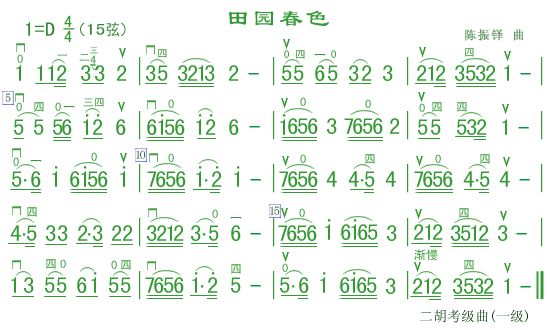Detailed teaching of pictures and texts of the famous Erhu song "Pastoral Spring"
The next piece is an etude in the key of D major. The tuning of the erhu is (1 5) string. Four beats per measure (quarter notes are counted as one beat). Pulling can be done in the first position.
It should be noted that some "5" sounds use the outer string, while some use the little finger to press the inner string, the purpose is to make the melody more smooth, which also has the effect of timbre contrast and the convenience of changing strings.
Before practice, you can sing the tune once to become familiar with the melody, rhythm, pitch, etc. of the tune.
In terms of bowing, the longbow should be smooth and smooth, and the time values of the fourteen notes such as "3213" and "3532" should be uniform.

Difficulties in practicing this song
The difficulty in fingering of this song is mainly the pressing of the little finger. You can pay attention to the following points:
1. In general, it is necessary to pay attention to the finger shape to meet the requirements of the "full half full" finger shape required by D major. Try to keep each finger as relaxed as possible. Because the little finger tends to deviate from the strings when idle, special attention should be paid to the pre-pressing posture of the little finger during practice.
2. The little finger should be pressed elastically, and the joints of the little finger should be in an arc shape. When the little finger presses the finger downward, the center of gravity of the left hand should be kept relatively stable, and try not to pull the 1-2-3 fingers downward. At the same time, the position of the wrist and the tiger's mouth should be relatively stable. For example, the wrist should not protrude too much outwards. to maintain and stabilize the shape of the left hand. The stability of the ring finger directly helps the elasticity of the little finger.
3. The two "5" sounds in the 3rd, 5th, 8th and other measures should be played on different strings, and the pressing of the little finger should be correctly matched with the string change. The little finger is the weakest, and the practice of splitting the little finger should be strengthened. The little finger is often not in place (the habitual sound is low), especially for those with short fingers, it is necessary to pay more attention to the independence of the little finger and the sensitivity of the finger.
4. For those with shorter fingers, the tiger's mouth can be moved down appropriately, and the little finger can only be in a straight state. When practicing, the little finger should be consciously lowered and the ring finger should be moved upwards (try to keep 3-4 fingers apart).
The following is the practice of pressing the little finger on the erhu:

When practicing, keep the index finger stable. The purpose of retaining the index finger is to remember the distance between 1-4 fingers and cultivate the feeling of the hand.
In order to avoid stiffness of the index finger, it is best to press the index finger on the string.
 渝公网安备 50010702504639号
渝公网安备 50010702504639号